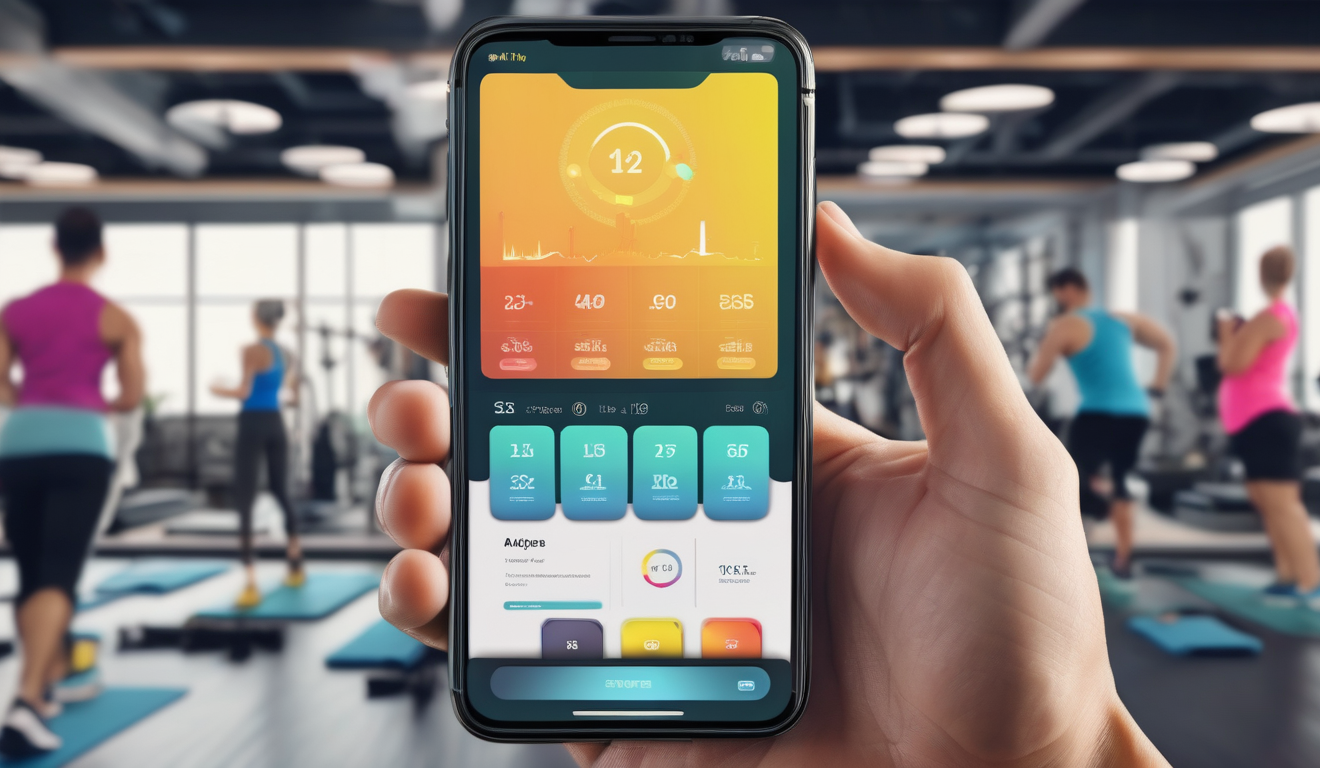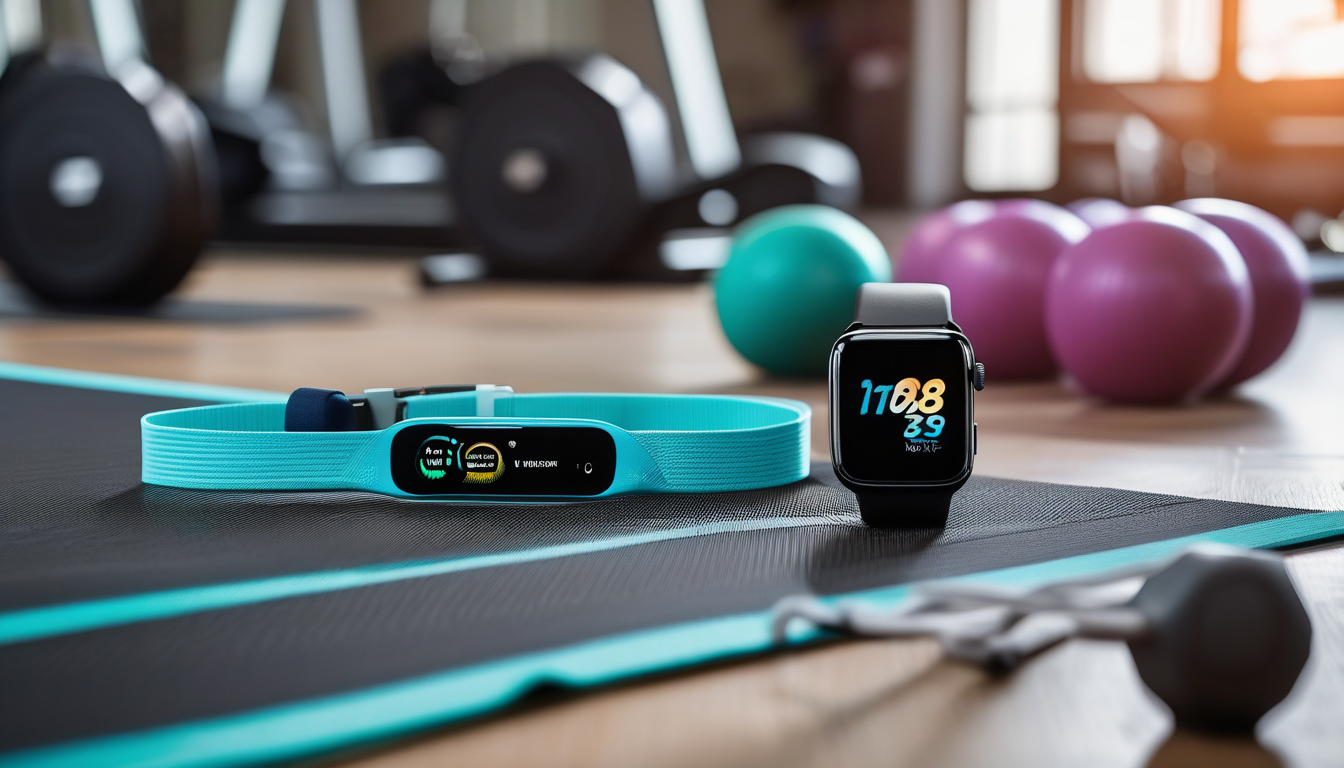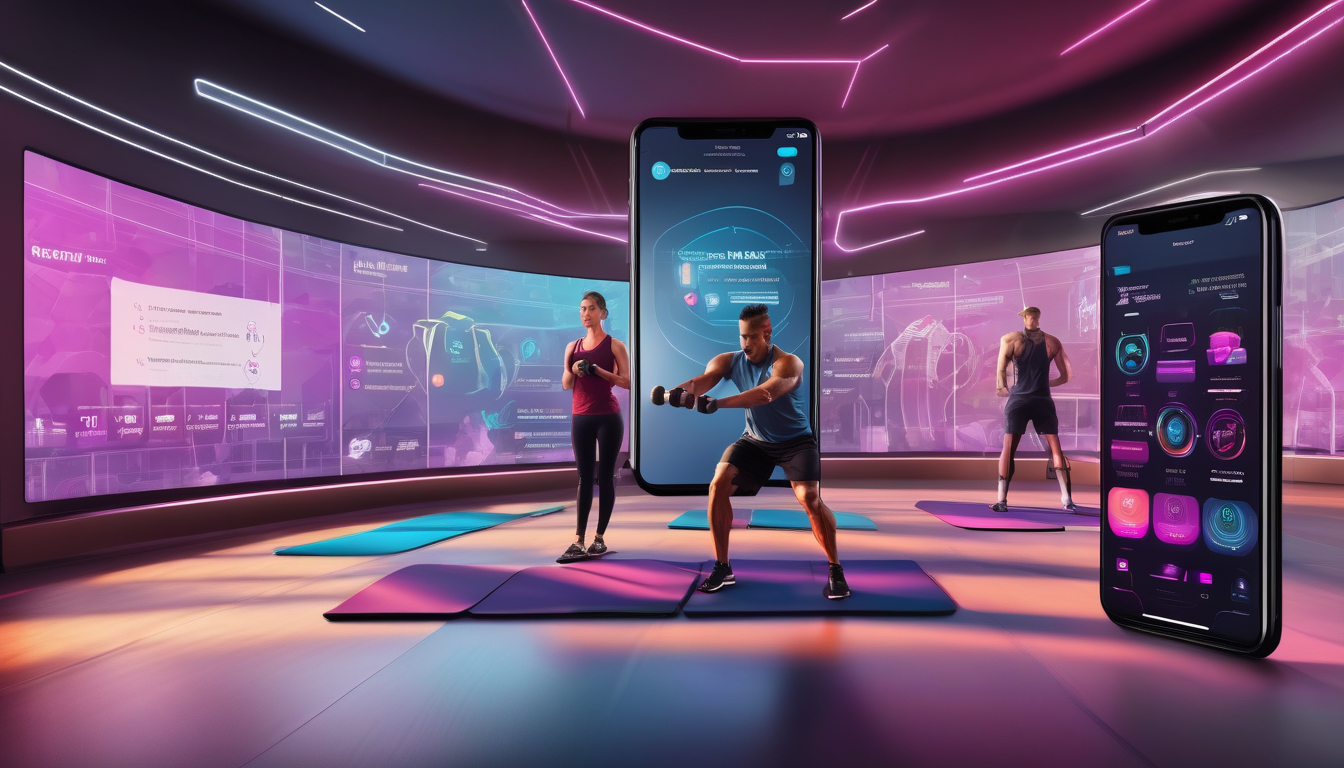How Mobile Apps Are Changing the Fitness Industry

The fitness industry is undergoing a **remarkable transformation** thanks to mobile applications. These apps are not just tools; they are becoming essential partners in our journey toward better health and fitness. Imagine having a personal trainer, nutritionist, and community support all in your pocket! This shift reflects a broader trend where technology meets personal wellness, making fitness more accessible and engaging than ever before.
With a simple tap on your smartphone, you can access a world of fitness resources. From personalized workout plans to real-time nutrition tracking, mobile apps are redefining how we approach our fitness goals. This surge in popularity is largely due to the convenience and customization these apps provide. Users are no longer bound by the limitations of traditional gyms or rigid workout schedules. Instead, they can choose when, where, and how they want to work out, making fitness a more integral part of their daily lives.
One of the standout features of these applications is their ability to offer tailored experiences. By leveraging user data, fitness apps can create personalized workout regimens and dietary recommendations that align with individual goals. This level of personalization not only keeps users motivated but also fosters a deeper connection to their fitness journey. Imagine receiving a notification that says, “You’ve burned 300 calories today! Keep it up!” Such encouragement can be a game-changer in maintaining commitment to a fitness routine.
Moreover, the integration of social features within these apps has cultivated a vibrant community of fitness enthusiasts. Users can share their progress, join challenges, and support one another, creating a sense of accountability that is often missing in solitary workout sessions. This community aspect is vital; it transforms the fitness journey from a solitary endeavor into a shared experience, making it more enjoyable and sustainable.
In conclusion, mobile apps are not just changing the fitness industry; they are revolutionizing it. As we look to the future, we can expect even more innovative features, such as AI coaching and virtual reality workouts, to further enhance our fitness experiences. With technology at our fingertips, the possibilities for achieving healthier lifestyles are limitless.

The Rise of Fitness Apps
Fitness apps have taken the world by storm, transforming how we approach health and wellness. In recent years, these applications have surged in popularity, becoming indispensable tools for fitness enthusiasts and casual users alike. With just a few taps on a smartphone, users can access a treasure trove of personalized workout plans, nutrition tracking, and social connectivity. This trend reflects a growing reliance on technology to achieve fitness goals, making it easier than ever to stay on track.
One of the most appealing aspects of fitness apps is their ability to offer tailored experiences. Imagine having a personal trainer in your pocket, ready to guide you through workouts and meal plans that fit your unique lifestyle. By leveraging user data, fitness apps can craft customized routines that adapt to individual preferences and progress. This personalization is crucial for keeping users motivated and engaged, ultimately leading to better adherence to fitness routines and healthier habits.
Moreover, the rise of fitness apps has paved the way for a more data-driven approach to health. These applications are designed to collect and analyze user data, providing actionable insights that help individuals understand their progress. For instance, many apps allow users to track various metrics such as:
- Workout duration and intensity
- Caloric intake and expenditure
- Body measurements and weight changes
This wealth of information empowers users to make informed decisions about their health and fitness journey, ensuring they remain on the path to success.
As technology continues to evolve, the impact of fitness apps on the industry will only grow. They are not just a passing trend; they represent a fundamental shift in how we approach fitness. With the integration of social features, users can connect with friends and family, fostering a sense of community and accountability. This connectivity enhances the overall fitness experience, turning solitary workouts into shared journeys.
In conclusion, the rise of fitness apps marks a significant turning point in the fitness industry. They provide the tools and motivation needed to achieve personal health goals, proving that the future of fitness is not just about hard work but also about smart strategies and community support.

Personalization and User Experience
In today’s fast-paced world, personalization has become the key to unlocking user engagement in fitness apps. Imagine walking into a gym where every machine knows your name and your fitness goals—this is the kind of experience mobile apps aim to create. By leveraging user data, these applications can offer tailored experiences that resonate deeply with individual users. Whether you’re a seasoned athlete or just starting your fitness journey, the right app can feel like having a personal trainer in your pocket.
One of the most significant advantages of fitness apps is their ability to adapt to your unique needs. They analyze your preferences, workout history, and health metrics to craft a personalized plan just for you. This means that instead of a one-size-fits-all approach, you receive a program that evolves as you do. For instance, if you consistently skip leg day, your app might nudge you with reminders or suggest engaging leg workouts that keep you excited about your routine.
Moreover, personalization extends beyond just workouts. Nutrition tracking features allow users to log their meals and receive tailored dietary suggestions. This integration of fitness and nutrition is crucial for anyone looking to achieve their health goals. Users can easily see how their food choices impact their performance, making it easier to adjust their diets for optimal results.
To illustrate this, consider the following table that outlines the benefits of personalization in fitness apps:
| Benefit | Description |
|---|---|
| Motivation | Customized reminders and challenges keep users engaged and motivated. |
| Progress Tracking | Users can visualize their progress through personalized metrics and feedback. |
| Goal Setting | Apps help users set achievable goals based on their data and preferences. |
Ultimately, the goal of these apps is to create an environment where users feel supported and understood. By fostering a sense of connection and accountability, fitness apps can transform the often solitary journey of getting fit into a more engaging and communal experience. It’s like having a workout buddy who knows exactly what you need, cheering you on every step of the way!
Data-Driven Insights
In today’s fast-paced world, fitness apps have become more than just tools for tracking workouts; they are powerful platforms that harness the power of data to transform how we approach health and fitness. By collecting and analyzing user data, these apps provide actionable insights that empower individuals to take control of their fitness journeys. Imagine having a personal trainer in your pocket, one that knows your habits, preferences, and even your goals! This is what data-driven insights offer to users.
One of the remarkable aspects of fitness apps is their ability to track a variety of metrics. Users can monitor everything from calories burned to the number of steps taken each day. This data isn’t just numbers on a screen; it tells a story about your progress and helps you make informed decisions. For instance, if you notice a dip in your activity levels, the app can prompt you to step it up with tailored suggestions. This level of personalization is crucial for maintaining motivation and commitment.
Furthermore, fitness apps often utilize data visualization techniques to help users see their progress over time. Consider a simple graph that shows your weekly workouts; this visual representation can be incredibly motivating. When you see how far you’ve come, it’s like a burst of energy that pushes you to keep going. Progress tracking can include:
- Daily step count
- Workout duration
- Caloric intake versus expenditure
By leveraging this data, users can set realistic goals and celebrate small victories along the way, making the journey toward better health feel less daunting. Additionally, fitness apps can analyze user behavior to identify patterns. For example, if the app notices that you tend to skip workouts on Fridays, it might suggest a fun workout challenge to help you stay on track. This kind of behavioral adaptation is key to forming lasting habits.
In conclusion, data-driven insights are revolutionizing how we engage with fitness. They not only provide users with the tools to track their progress but also offer the motivation and support needed to make meaningful changes. As technology continues to advance, we can only expect these insights to become even more sophisticated, paving the way for a healthier future.
Tracking Progress
In the fast-paced world of fitness, tracking progress is more crucial than ever. Imagine stepping onto the scale only to find a number that doesn’t reflect your hard work. Frustrating, right? That’s where mobile apps come into play, acting as your personal fitness diary. These apps allow users to monitor their workouts, keep tabs on nutrition, and assess overall health metrics, all in one convenient place.
With the ability to visualize progress, users can set realistic goals and celebrate small victories along the way. Whether it’s logging daily workouts or tracking caloric intake, the data collected provides a roadmap to success. For instance, many apps feature intuitive dashboards that display key metrics such as:
- Workout Duration: How long you’ve exercised each day.
- Calories Burned: A clear view of your energy expenditure.
- Weight Changes: Trends over time to see how your body responds.
- Nutrition Intake: Monitoring macronutrients and vitamins consumed.
By visualizing this data, users can make informed decisions about their fitness journey. For example, if someone notices they’re consistently burning fewer calories than they consume, they might adjust their diet or ramp up their workouts. This kind of insight is invaluable, transforming vague feelings of progress into concrete, actionable steps.
Moreover, many fitness apps include features like goal-setting and reminders, which keep users accountable. Imagine setting a goal to run a 5K and being able to track your distance and pace over weeks. Each run becomes a stepping stone, and seeing those numbers improve can be incredibly motivating.
Ultimately, tracking progress through fitness apps not only enhances motivation but also fosters a deeper understanding of one’s body and fitness levels. It’s like having a personal coach in your pocket, guiding you towards your goals while celebrating your achievements. So, if you’re not already using a fitness app, now’s the time to dive in and start tracking your journey!
Behavioral Adaptation
Behavioral adaptation is a fascinating aspect of how fitness apps influence our daily lives. These applications go beyond just tracking workouts; they actively encourage users to modify their behaviors for better health outcomes. Imagine having a virtual coach in your pocket that nudges you towards healthier choices! Through personalized reminders, challenges, and rewards, fitness apps create a dynamic environment that promotes positive changes.
For example, many fitness apps send notifications to remind users to stay active, drink water, or even take a moment to stretch. This constant engagement can make a significant difference in forming new habits. It’s like having a friend who always cheers you on, pushing you to achieve your goals. Moreover, by analyzing user behavior, these apps can tailor their suggestions to fit individual lifestyles. This means that if you tend to skip workouts on weekends, the app might offer motivational content or suggest lighter activities to keep you moving.
Additionally, many apps incorporate gamification elements, turning fitness into a fun and rewarding experience. Users can earn points for completing workouts, reaching milestones, or participating in community challenges. This not only makes exercising more enjoyable but also fosters a sense of competition and accountability among friends and fellow users. The social aspect of these apps is crucial; when you see your friends achieving their goals, it can inspire you to push a little harder.
Furthermore, the data collected by these apps provides valuable insights that help users understand their habits. By visualizing progress through charts and graphs, individuals can see how their efforts translate into results. This transparency is vital for motivation—when you can see your improvements, it reinforces your commitment to a healthier lifestyle.
In summary, fitness apps play a pivotal role in behavioral adaptation. They leverage technology to not only track progress but also to inspire users to make lasting changes. By integrating reminders, gamification, and data analysis, these apps create a supportive framework that encourages individuals to embrace healthier habits and transform their fitness journeys.
Community and Social Features
In the world of fitness, going solo can sometimes feel like running a marathon without a finish line. This is where the of fitness apps step in to change the game. These functionalities create a vibrant ecosystem where users can connect, share, and motivate each other, making the journey towards fitness goals not only more enjoyable but also more achievable.
Imagine logging into your favorite fitness app and seeing a feed filled with achievements from friends and fellow users. It’s like having a personal cheer squad right at your fingertips! Many apps offer features such as leaderboards, challenges, and community forums that foster a sense of belonging. Users can join groups based on their interests or fitness levels, which encourages accountability and support. Whether it’s sharing workout tips or celebrating milestones, these interactions can significantly boost motivation.
Moreover, the integration of social media elements within fitness apps allows users to share their progress on platforms like Instagram or Facebook. This not only amplifies their achievements but also inspires others to join the fitness movement. Some apps even allow for real-time sharing of workouts, enabling users to invite friends to join them virtually. This kind of interaction transforms fitness from a solitary pursuit into a collective experience.
To illustrate the impact of community features, consider the following table that showcases the benefits of social connectivity in fitness apps:
| Benefit | Description |
|---|---|
| Accountability | Having friends track their progress can motivate individuals to stick to their routines. |
| Support | Sharing struggles and successes creates a supportive environment that encourages persistence. |
| Inspiration | Seeing others achieve their goals can ignite a spark of motivation in users. |
Ultimately, the community aspect of fitness apps transforms the way we approach our health. It’s not just about the numbers on a scale; it’s about building a network of support that propels us forward. So, the next time you lace up your sneakers, remember that you’re not just on a personal journey—you’re part of a thriving community that’s cheering you on every step of the way!

Integration with Wearable Technology
The integration of mobile apps with wearable technology has revolutionized how we approach fitness. Imagine having a personal trainer right on your wrist, guiding you through workouts and tracking your every move. This synergy not only enhances the user experience but also takes fitness tracking to a whole new level. With devices like smartwatches and fitness bands, users can seamlessly monitor their health metrics in real time, making fitness more accessible and engaging than ever before.
One of the standout features of this integration is the enhanced tracking capabilities. Wearable devices collect a wealth of data, including heart rate, calories burned, and even sleep patterns. This data is then synced with fitness apps, allowing users to gain a comprehensive view of their health journey. For instance, a user can see how their heart rate fluctuates during different workouts, helping them adjust their intensity for optimal results. The combination of mobile apps and wearables creates a powerful feedback loop that keeps users informed and motivated.
Moreover, the real-time feedback provided by these technologies is invaluable. Picture this: you’re in the middle of a high-intensity workout, and your smartwatch buzzes to inform you that your heart rate is peaking. This immediate feedback enables you to modify your efforts on the fly, ensuring that you’re pushing your limits safely. It’s like having a coach whispering in your ear, urging you to give it your all while also reminding you to listen to your body.
As the fitness landscape continues to evolve, the possibilities for integrating mobile apps with wearable technology are endless. From personalized workout recommendations based on your daily activity levels to challenges that encourage friendly competition among friends, the future is bright. This integration not only promotes a healthier lifestyle but also fosters a sense of community among users.
In conclusion, the marriage of mobile apps and wearable technology is a game-changer in the fitness industry. Together, they empower individuals to take charge of their health with unprecedented precision and support. As we move forward, we can expect even more innovative features that will further enhance our fitness journeys.
Enhanced Tracking Capabilities
When it comes to fitness, knowledge is power, and offered by mobile apps and wearable technology have revolutionized how we approach our health and fitness journeys. Imagine having a personal trainer, nutritionist, and health coach all wrapped up in a device that fits on your wrist! These advancements allow users to monitor their progress in real-time, ensuring that every step, rep, and calorie is accounted for.
One of the most significant benefits of this integration is the ability to track various health metrics effortlessly. Users can now monitor:
- Heart Rate: Keeping tabs on your heart rate helps you train within your optimal zones for maximum efficiency.
- Calories Burned: Knowing how many calories you’ve burned during a workout can help you adjust your nutrition accordingly.
- Activity Levels: Whether you’re walking, running, or lifting weights, tracking your activity levels can motivate you to reach your daily goals.
Moreover, the seamless connection between fitness apps and wearable devices enables users to receive real-time feedback during their workouts. This means you can make instant adjustments to your form or intensity, ensuring safety and effectiveness. For instance, if your heart rate spikes too high during a run, the app can alert you to slow down, preventing potential injuries.
Additionally, many apps now feature smart reminders that encourage users to stay active throughout the day. These reminders can be a game-changer, especially for those with busy schedules. Picture this: your app buzzes to remind you to take a quick walk after sitting for too long. It’s like having a personal cheerleader in your pocket!
As we look to the future, the possibilities for enhanced tracking capabilities are virtually limitless. With advancements in technology, we can expect even more sophisticated features, such as AI-driven analytics that provide personalized insights based on your unique data. This level of customization could lead to a more engaging and effective fitness experience, making it easier than ever to achieve your health goals.
Real-Time Feedback
Imagine you’re in the middle of a workout, beads of sweat trickling down your forehead, and your heart is racing. Suddenly, your fitness app buzzes gently, providing you with on your performance. This instant information is a game changer, allowing you to adjust your intensity and technique on the fly. It’s like having a personal trainer right in your pocket!
With the integration of wearable technology, fitness apps can monitor various metrics, such as heart rate, calories burned, and even your form during exercises. This data is not just numbers; it translates to actionable insights that can enhance your workout experience. For instance, if your heart rate spikes too high, the app can suggest that you slow down or take a breather. Similarly, if you’re not pushing yourself hard enough, it can encourage you to amp up your efforts.
Here are some key benefits of real-time feedback:
- Immediate Adjustments: You can alter your workout based on live data, ensuring you’re always optimizing your performance.
- Enhanced Safety: Real-time alerts can prevent injuries by notifying you if your form is off or if you’re overexerting yourself.
- Increased Motivation: Seeing your progress in real-time can boost your morale and keep you committed to your fitness goals.
Furthermore, this immediate feedback fosters a deeper connection between users and their fitness journeys. It transforms workouts from a solitary endeavor into an interactive experience. Users can feel a sense of accomplishment every time they receive a notification that they’ve reached a milestone or improved their performance. It’s like getting a virtual high-five from your app!
As technology continues to advance, we can expect even more sophisticated feedback mechanisms. Imagine a future where your app not only tracks your performance but also provides personalized coaching tips based on your historical data. This level of customization will not only enhance user engagement but also revolutionize how we approach fitness.

Future Trends in Fitness Apps
The future of fitness apps is bright and brimming with possibilities that will reshape how we approach health and wellness. As technology continues to advance, we can expect to see innovative features that not only enhance user experience but also make fitness more accessible and engaging for everyone. Imagine a world where your fitness app acts as a personal trainer, nutritionist, and motivational coach all rolled into one!
One of the most exciting trends on the horizon is the integration of artificial intelligence (AI). AI-driven coaching can provide users with personalized workout plans that adapt in real-time based on performance and feedback. This means that if you’re struggling with a particular exercise, the app can modify your routine to better suit your needs, ensuring that you stay on track without feeling overwhelmed.
Additionally, virtual reality (VR) is set to make waves in the fitness industry. Imagine putting on a VR headset and being transported to a serene beach while you practice yoga or a bustling cityscape while you run. This immersive experience can make workouts more enjoyable and less of a chore. Users will not only be able to exercise but also escape into different environments, enhancing their motivation and engagement.
Moreover, the rise of community-driven features will continue to grow. Fitness apps are increasingly incorporating social elements that allow users to connect with friends, join challenges, and share achievements. This sense of community can be a powerful motivator, helping individuals stay accountable and inspired. For instance, users might participate in virtual races or group challenges, fostering camaraderie and competition.
| Trend | Description |
|---|---|
| AI Coaching | Personalized workout plans that adapt in real-time. |
| Virtual Reality | Immersive environments for a more engaging workout experience. |
| Community Features | Social connectivity through challenges and shared achievements. |
As we look to the future, it’s clear that fitness apps will not just be tools for tracking workouts but will evolve into comprehensive platforms that promote healthier lifestyles. With these advancements, the fitness journey will become more interactive, engaging, and tailored to individual needs. So, are you ready to embrace the future of fitness?
Frequently Asked Questions
- What are the main benefits of using fitness apps?
Fitness apps offer a plethora of benefits, including personalized workout plans, nutrition tracking, and community support. They make it easier to stay motivated and accountable, helping users achieve their fitness goals more effectively.
- How do fitness apps personalize my experience?
Fitness apps use data collected from your activities, preferences, and goals to tailor your experience. This means you receive recommendations that align with your fitness level and objectives, keeping you engaged and motivated.
- Can fitness apps help me track my progress?
Absolutely! Most fitness apps come equipped with tracking features that allow you to monitor your workouts, nutrition, and health metrics. This visual representation of your progress can be incredibly motivating.
- Are fitness apps compatible with wearable technology?
Yes, many fitness apps seamlessly integrate with wearable devices like smartwatches. This synergy enhances your tracking capabilities, providing real-time data and feedback to optimize your workouts.
- What future trends can we expect in fitness apps?
As technology advances, we can anticipate exciting features like AI coaching, virtual reality workouts, and enhanced social connectivity. These innovations will continue to transform the fitness landscape and user experience.
- How do community features in fitness apps enhance my experience?
Community features foster a sense of belonging and accountability among users. By connecting with others, you can share achievements, participate in challenges, and receive support, making your fitness journey more enjoyable.













